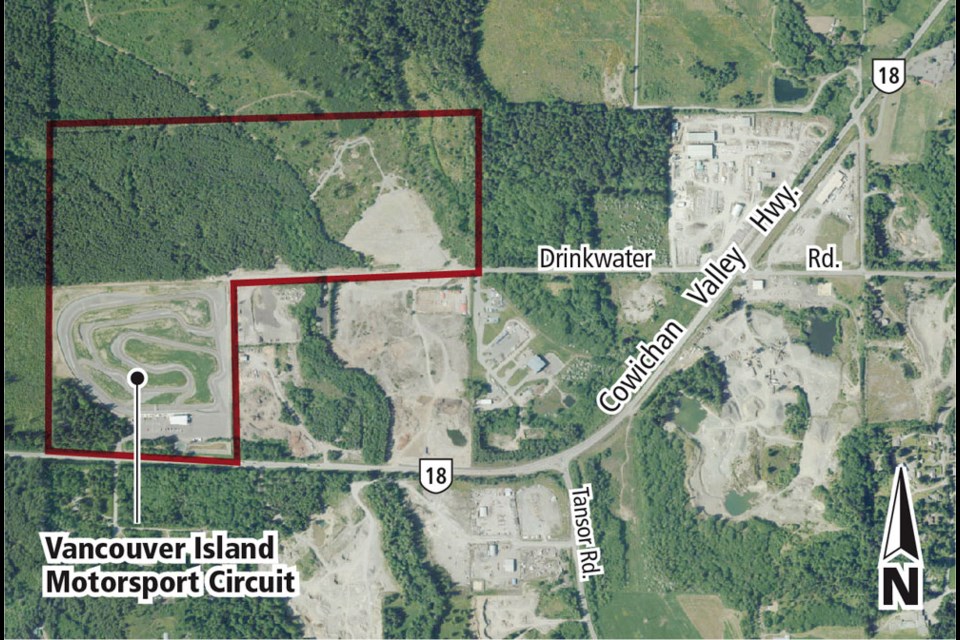The Vancouver Island Motorsport Circuit says it will not proceed with a rezoning application for an expansion of its track, preferring legal action and studying other uses for its property, but North Cowichan plans to go ahead with a public hearing anyway.
On Thursday, VIMC sent a letter to North Cowichan council saying it no longer wishes to proceed with the rezoning application “that the municipality initially requested and then refused.”
The letter, sent a day after council denied a development permit application from the company for a second phase of the track, says VIMC will not attend a second public hearing, set for Monday at the Cowichan Performing Arts Centre.
The hearing was prompted by a reconsideration of the rezoning application in light of a potential $60-million lawsuit by VIMC.
“VIMC’s perspective is that in denying the development permit, the municipality’s about-face is complete and legal processes will necessarily follow. While it seeks remedies and compensation in the courts for its substantial losses, VIMC will proceed to mitigate its losses, as it must, by extracting whatever value it can from alternative uses of its land,” said the letter signed by Sean Hern, a lawyer with Farris LLP.
Hern could not be reached for comment.
Parts of the VIMC property are zoned heavy industrial, where permitted uses include sawmills, slaughterhouses, auto-wrecking and cannabis production.
Vancouver Island Motorsport Circuit initially opened the track on 18.74 hectares in June 2016. It planned to build another phase with a second track on 42.47 hectares just north of the existing site, most of which is under the same heavy-industrial zoning as the first phase.
The company argued it could simply file for a development permit for the second phase, because the land use and zoning is essentially the same as in the first phase.
That process would not have required a public hearing.
However, on the advice of the municipality, the company applied for a rezoning that would put its three parcels of land in North Cowichan — two industrial parcels and one recreational-use parcel — under one new comprehensive development zone.
The company said the expansion was a $36-million-plus investment that would create about 200 construction jobs and nearly 30 full-time jobs. In response to community concerns, including complaints about noise, the company offered concessions, amenities and noise-mitigation measures.
After council received a letter from Cowichan Tribes Chief William Seymour criticizing the plan, council decided the expansion would run counter to the municipality’s environmental priorities and Indigenous-relations goals and voted it down.
On Friday, North Cowichan Mayor Al Siebring said a proposed bylaw to amend the zoning is still under consideration. “The public hearing is a procedural requirement that must be undertaken before council can vote on that reconsideration,” said Siebring. “The fact that VIMC has withdrawn the rezoning application does not mean that council does not need to reconsider Bylaw 3761.”
The public hearing will give people an opportunity to provide input on “new information” — the potential lawsuit and its financial implications — before council reconsiders the bylaw, said Siebring.
Council is aware that VIMC has withdrawn its application and commitments and council may consider that fact when third reading of the bylaw is reconsidered, said the mayor.
Council is already preparing to be sued. At a special closed meeting Oct. 16, council directed staff to prepare a report on establishing a liability reserved fund relating to the VIMC file. Council asked that the report recommend an annual amount to be included in the reserve for the next five years, or until the claim is managed.
“If we get sued and we have $20 million worth of insurance, but potentially the lawsuit is $60 million, we have $40 million uninsured. So how do we cover that?” said Siebring.
The report says the VIMC claim, if successful, could have devastating implications over the next 10 years. If a $60-million judgment were awarded, the district has two options, says the report: a one-time tax increase of 133 per cent — $2,164 for an average home and $8,134 for an average business — or borrowing the money over 10 years.
The borrowing option would result in loan payments of $4.6 million per year, equating to a 15 per cent tax increase — $250 per year for 10 years for the average home, or $2,500 in total. The average business tax would increase by $930 over 10 years, for a total of $9,300. Total interest paid by the municipality would be $5.7 million.
In addition to these tax increases, an additional tax increase of three per cent would be required to pay for insurance premiums during those 10 years.
“The tax ramifications for any judgment in the range of $40 million to $60 million are staggering,” says the report. “At $40 million, this is equivalent to two RCMP buildings or two aquatic centres. Borrowing would make increases slightly more palatable, but would use up a large portion of the district’s borrowing power and cost millions in interest.”
Staff recommended that the information be made public as part of the public-hearing process to ensure transparency in council’s decision.



